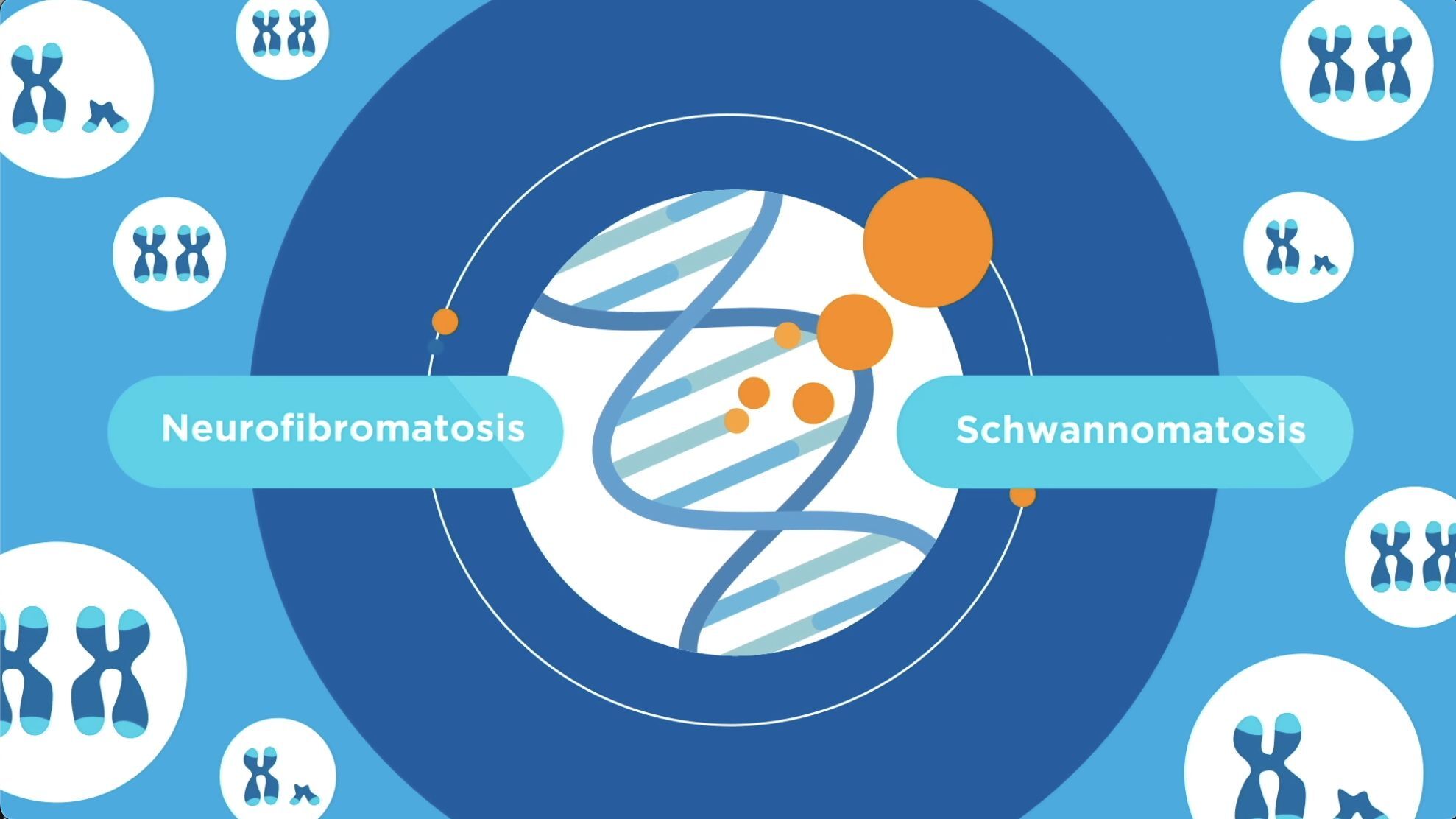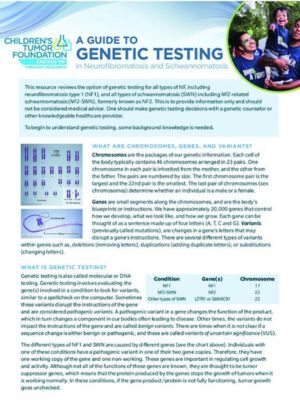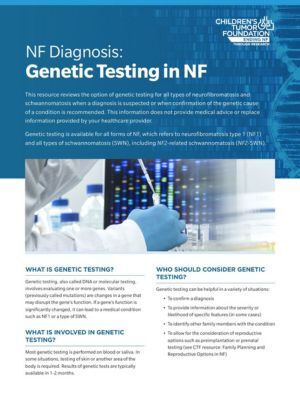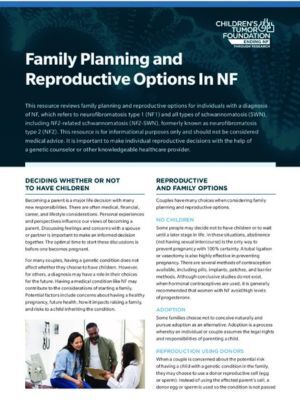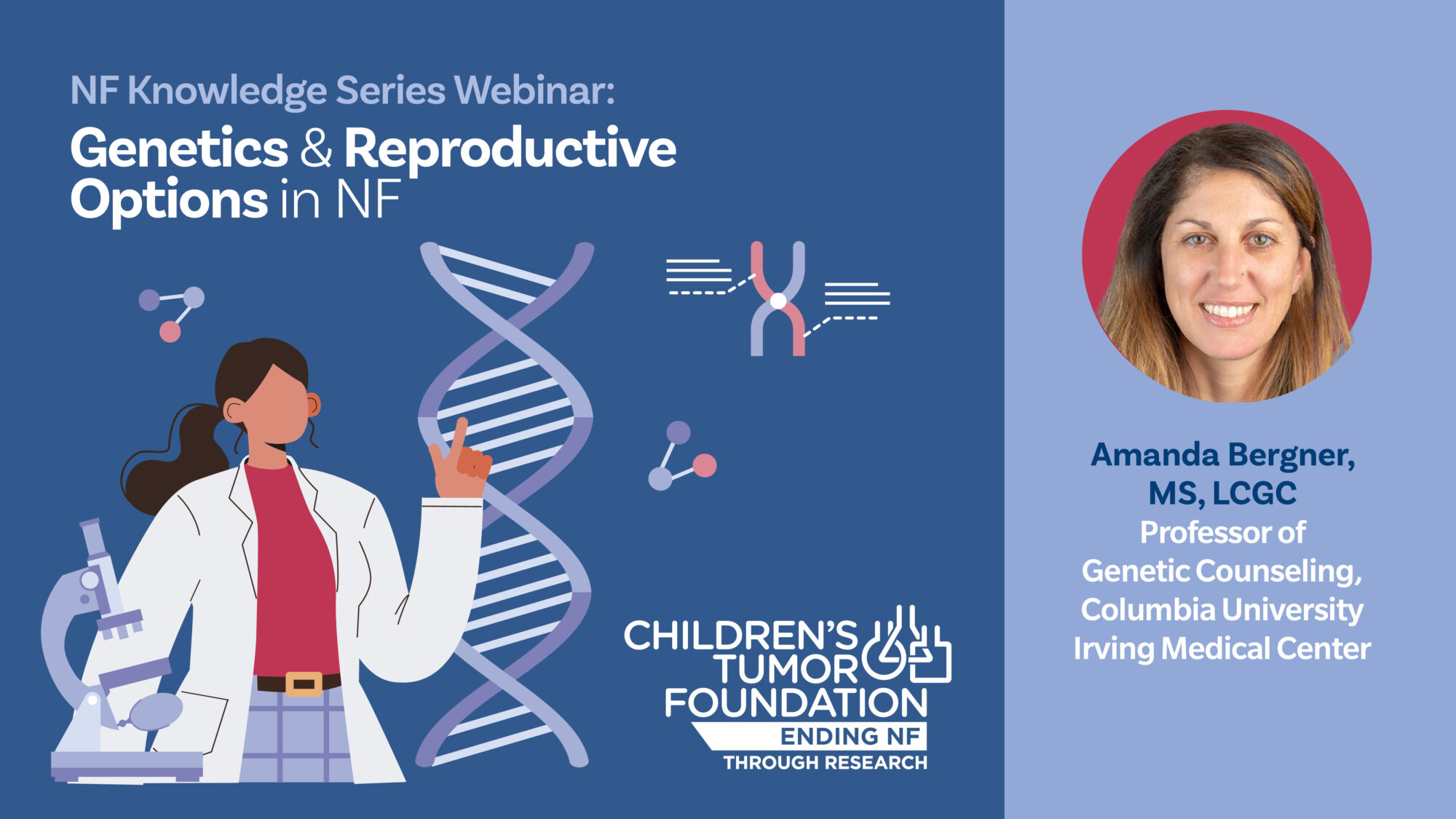NF begins with a change in genes at a cellular level. Certain genes are meant to stop tumor growth—but when they don’t work properly, tumors can form.
Genetics of NF
What causes tumors to grow in a person with NF?
The genes involved in NF are important in controlling and stopping cell growth and division. If there is a change in the gene (a pathogenic variant, formerly called a mutation) that causes the gene not to function correctly, cells continue to divide, and a tumor forms. Therefore, the genes are referred to as tumor suppressor genes because, in their normal form, they stop uncontrolled cell division.
Video Transcript: The Genetics of NF: Autosomal Dominance
Today, we are going to talk about a related set of genetic disorders that can cause tumors to grow on nerves throughout the body. This group of disorders includes all forms of neurofibromatosis and schwannomatosis, also known as NF.
Most children and adults living with these genetic disorders experience only mild symptoms, yet some experience more difficult manifestations such as blindness, deafness, bone abnormalities, learning difficulties, disfigurement, pain, or cancer.
NF is not contagious, it affects both males and females and people of every population equally. Genes determine our characteristics such as height, eye color, and blood type. Genes also determine the way our body develops and functions. If a gene is not functioning properly, it may lead to conditions such as an NF.
Genes are located on chromosomes. Each of us normally inherits 23 chromosomes from our mom and 23 from our dad for a total of 46 chromosomes. The first 22 pairs of chromosomes are numbered one through 22 and called autosomes. The 23rd pair influences whether we are male or female and are called sex chromosomes, X and Y.
Each type of neurofibromatosis or schwannomatosis is caused by a pathogenic variant in a gene. Pathogenic variant is a newer term for what was previously called a mutation and means a change in the coding of the gene that causes it to function incorrectly. The NF genes are called tumor suppressor genes because when they function correctly, they suppress tumor formation.
Approximately half of individuals with NF inherit the condition from one of their parents. The other half inherit these disorders as a result of a spontaneous change in one of the genes before birth or soon after an embryo develops. A parent with NF has a 50% chance of passing on the variant gene, leading to a child with NF. Likewise, that parent has a 50% chance of passing on the functioning gene, leading to a child not having NF.
It’s like flipping a coin. With each pregnancy, a parent with NF has a 50/50 chance of having a child with NF and 50/50 chance of the child not having NF. This is called autosomal dominant inheritance. Because the genes for neurofibromatosis and schwannomatosis do not involve the sex chromosomes, they’re autosomal and dominant, which means that it takes only one copy of the variant gene to cause either disorder. Some conditions result from having two copies of variant genes, and those are referred to as recessive. If a child of someone with NF does not inherit the variant NF gene they do not have NF and therefore cannot pass it on to their children.
We hope this video helps you understand neurofibromatosis and schwannomatosis and other autosomal dominant genetic disorders. We hope you’ll share this video with others. At the Children’s Tumor Foundation, we are committed to finding treatments for all forms of NF. To find out more, visit the Children’s Tumor Foundation at ctf.org.
Is NF hereditary?
Neurofibromatosis Type 1 (NF1) or NF2-Related Schwannomatosis (NF2-SWN)
Approximately half of individuals with neurofibromatosis type one (NF1) or NF2-related schwannomatosis (NF2-SWN), formerly referred to as neurofibromatosis type 2, inherit the condition from one of their parents. The other half develop it as the result of a spontaneous (also called new or de novo) change in one of the NF genes in the egg or sperm cell during conception.
Both NF1 and NF2-SWN follow autosomal dominant inheritance. This means that individuals with either of these conditions have a 50% chance of passing the condition on to their offspring. If a child inherits the variant NF gene, they will always show symptoms of the condition, however, it is difficult to predict the severity, especially in NF1. This is called variable expressivity. If a child of someone with NF does not inherit the variant NF gene, they do not have NF and, therefore cannot pass it on to their future children. That is to say, NF cannot “skip a generation.”
Other Types of Schwannomatosis (SWN)
The inheritance of the other types of schwannomatosis is less well understood and appears to involve more than one gene. Regardless, most schwannomatosis cases appear to occur by chance and are not inherited. However, once an individual has schwannomatosis, it may be inherited as an autosomal dominant condition, and therefore, the chance of someone with schwannomatosis having a child with the condition may be 50%. Contrary to NF1 and NF2-SWN, not all individuals in a family with schwannomatosis will develop tumors or show signs of having the condition. This is called reduced penetrance.
Genetics Resources
A review of the option of genetic testing when a diagnosis is suspected or when genetic testing is recommended.
A comprehensive guide to help patients understand all that is involved in genetic testing for NF and what they can expect.
This resource reviews family planning and reproductive options for individuals with a diagnosis of any type of NF.
Click the Blue Play Button to Watch
This webinar is part of the Children’s Tumor Foundation NF Knowledge Series and was recorded live on May 8, 2025. Hosted by Amanda Bergner, MS, LCGC, a genetic counselor with over 20 years of experience, the webinar also discussed CTF’s new educational materials on genetics and family planning. You can access those materials in this Genetics Resources section.
What is the difference between Segmental NF and Mosaic NF?
Segmental NF and mosaic NF are similar in that there is a mixture of cells with and without the NF gene change. It is thought that this is the result of a genetic change that occurred after conception leading to a combination of normal and abnormal cells. Individuals with segmental or mosaic types of conditions are at risk of having children with the genetic change in all of their cells and therefore may be more severely affected than the parent.
In segmental NF, the area that is involved is typically confined to a specific area of the body such as an arm, half of the body or along the spine.
- Segmental NF1 may appear as an area of the body with skin changes such as café-au-lait spots, freckling or neurofibromas. Some individuals may have an isolated finding of NF1, such as a plexiform neurofibroma, but no other signs of NF1. It is not known whether such isolated tumors represent true cases of segmental NF1 or whether they occur due to other causes.
- Segmental NF2-SWN often appears as NF2-related tumors confined to a specific area of the body.
- Segmental Schwannomatosis accounts for 1/3 of individuals with schwannomatosis and causes tumors limited to a single part of the body.
Contrary to segmental NF, in mosaic NF the affected area may not be confined to a specific area and may appear as a milder case of the condition or may affect various areas throughout the body.
For more information, please contact a genetic counselor or talk with your NF provider.

